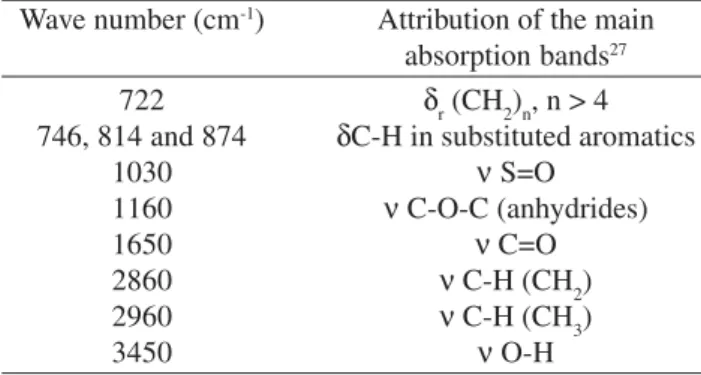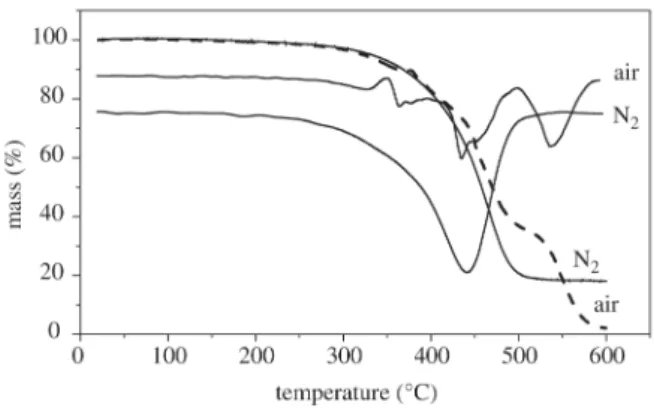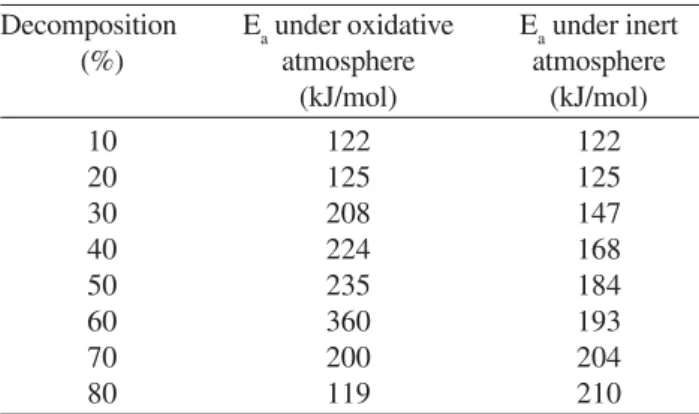*e-mail: sas@ufc.br
Article presented at the XV CBECIMAT, Natal - RN, November/2002
Characterization and Thermal Behavior of Polymer-Modified Asphalt
Maria da Conceição Cavalcante Lucena, Sandra de Aguiar Soares*,
Jorge Barbosa Soares
Dept. of Organic and Inorganic Chemistry, Dept. of Transportation Engineering Universidade Federal do Ceará
C.P. 12200, 60455-760, Fortaleza - CE, Brazil
Received: February 2, 2003; Revised: June 29, 2004
A styrene-butadiene-styrene modified asphalt cement was characterized by infrared, differen-tial scanning calorimetry, thermogravimetric analysis and empirical tests such as ring and ball softening point, penetration and elastic recovery. After aging in the rolling thin-film oven, the polymer-modified asphalt presented structural changes relating to oxidation of the material. The infrared spectra showed an increase in hydroxyl groups and the formation of carbonyl compounds and sulphoxides. The percentage of crystallized fraction calculated from differential scanning calorimetry was 0.41%. Thermogravimetric analyses in inert and oxidative atmospheres revealed distinct events during thermal decomposition; the initial activation energies were similar, but changed as the process evolved.
Keywords:modified asphalt characterization, SBS copolymer, thermal degradation
1. Introduction
Petroleum asphaltic cement (AC) composed of aromatic hydrocarbons, paraffins and resins has been used for a vari-ety of purposes, but most importantly for road surfacing1. Certain AC binder properties are required in this applica-tion to prevent the occurrence of three major pavement stresses, i.e., rutting, fatigue and thermal cracking. Pave-ment asphalt mixtures are sensitive to degradation agents such as heat, oxygen, ozone, chemicals, etc. to which they are exposed during their preparation, storage and service2. Thermo-oxidative processes lead to the formation of unsta-ble chemical structures which may induce deterioration of the physical and chemical properties of asphaltic surfaces. Considerable research in recent years has focused on improving the functional properties of the AC3. The use of synthetic polymers as additives, via chemical or physical blending, has been shown to greatly improve the perform-ance of conventional asphalts4. The thermoplastic nature of these binders has displayed the ability to combine proper-ties of elasticity, strength and adhesion to increase road life. Improved properties also include greater resistance to ag-ing and stability at high temperatures.
Thermoplastic copolymers such as
styrene-butadiene-styrene (SBS) have exhibited the greatest potential for bitu-men modification5. The SBS structure consists of a triblock chain having a two-phase morphology of styrenic block domains within a matrix of polybutadiene6. The polysty-rene end-blocks confer strength on the polymer, while the rubbery polybutadiene gives elasticity. When SBS is blended with AC, it is believed the elastomeric phase of SBS ab-sorbs the maltenes from the oil fractions, forming a con-tinuous network. The large-scale use of these polymers may be attributed to their networks, which are due to the rheologic properties of the modified binder and the interactions of bitumen constituents that increase the complex modulus and the elastic response7.
The addition of a SBS copolymer containing soft and glassy segments such as styrene-butadiene-styrene block is expected to affect the molecular microstructure of asphaltic material. In theory, the soft segments provide greater toughness and low temperature cracking, while the hard segments improve the material’s strength. The degree of modification depends on the nature of the base bitumen and on the AC-polymer compat-ibility. Thermal cracking, in particular, can be associated with phase separation, suggesting the immiscibility of the base bitu-men and the polymer10.
CAPFLEX is a SBS asphalt binder commercialized by Petrobras for road paving applications in Brazil, where bitumi-nous materials are characterized primarily on the basis of em-pirical testing methods. This article reports on a study of CAPFLEX, identifying some of the material’s physical and chemical properties and its thermal behavior. Parameters such as glass transition temperature (Tg) and amount of crystallized fractions were monitored by differential scanning calorimetry (DSC)11-13 and these data correlated with the thermal suscepti-bility of pavements. The degradation of the SBS-modified as-phalt was also studied using the rolling thin-film oven test (RTFOT) according to the recommendations of the Strategic Highway Research Program (SHRP)14 given in the Superior Performance Pavements (SUPERPAVE) specifications15. The aging process was monitored using techniques such as TGA and infrared (FTIR). The material was also characterized based on conventional empirical tests such as penetration16, softening point17, elastic recovery18 and viscosity at 135 °C19. Thermal analysis, commonly used for polymeric systems20, was also per-formed using thermogravimetry (TGA) to observe the degrada-tion process at a higher temperature and to study the kinetics. It is expected that the finding properties and parameters associated with thermal degradation should serve to underpin further stud-ies in this area of research.
2. Materials and Methods
2.1. Materials
The AC 20 modified with 4% of SBS (CAPFLEX) used in the present study is produced by Petrobras BR Distribuidora. The AC 20 was produced at REDUC (Refinaria Duque de Caxias) from Arabian light petroleum.
2.2. Methods
2.2.1. Sampling
The sampling of CAPFLEX for all the tests performed here followed the ASTM D140 standard21.
2.2.2. Characterization of CAPFLEX
The penetration test of the modified asphalt was performed at 25 °C, with a 10 g load applied for 5 s according to the ASTM
D5 specification. The softening point test was performed fol-lowing the ASTM D36 to obtain the penetration index of the modified asphalt. The elastic recovery (ASTM D6084) was also determined. The viscosity at 135 °C was measured using a Brookfield viscometer model DVII + attached to a THERMOSEL temperature controller.
2.2.3. Oxidative Aging
The aging was simulated in the RTFOT in accordance with the ASTM D2872 specification. Approximately 35 g of CAPFLEX were weighed, heated to 163 °C and held at that temperature for 85 min, after which the volatile content was calculated.
2.2.4. Structural Characterization by FTIR
The structural modifications after aging were investi-gated by infrared spectroscopy using a Shimadzu FTIR-8300 spectrometer. The spectra of the homogenized material, in the form of KBr discs, were analyzed in the range of 400 to 4000 cm-1.
2.2.5. Thermal Analysis
• DSC
The DSC curves were performed on 10 mg samples in an aluminum holder, under a nitrogen flow (100 mL.min-1) at a rate of 10 °C.min-1, in the range of -80 °C to 200 °C, using a Shimadzu DSC-50 calorimeter. Glass transition and paraffin dissolution were measured in the heating curve. The percentage of crystallized fractions (% Fc) was deter-mined from Eq.122:
% Fc = (∆H
obs × 100)/ 200 (1)
where ∆Hobs is the observed enthalpy relative to the dissolved par-affin in the CAPFLEX sample. A value of 200 J/g was considered, based on the fusion enthalpy of n-alkanes with a chain of carbon atoms between 30 and 4023.
• TGA
Thermal decomposition was verified in 10 mg samples in an aluminum holder under a nitrogen or air flow (50 cm3. min-1 ), heated from 25 to 600 °C at varying heating rates of 5, 10, 20 and 40 °C.min-1. The TGA curves and its differen-tial (DTG) were carried out in a Shimadzu TGA-50 thermogravimetric analyzer. The apparent activation energy as a function of the degree of decomposition in air and ni-trogen atmospheres was calculated by the Ozawamethod20.
3. Results and Discussion
3.1. Characterization of CAPFLEX
Table 1 compares the properties of CAPFLEX against those of unmodified AC 20.
unmodified AC, which was not expected. The penetration value typically decreases with increased copolymer content24. This unexpected result was attributed to the presence of a diluent added to the modified AC formulation. This diluent is commonly used to increase the materials’ compatibility. How-ever, as expected, the modified asphalt showed a higher sof-tening point and absolute viscosity at 135 °C8. The material’s elastic properties improved with the incorporation of the poly-mer, with elastic recovery increasing from 2.5% (AC) to 62.5% (CAPFLEX).
3.2. Oxidative Aging
A volatile content of 1.4% was obtained in the simulated aging of the modified asphalt by RTFOT. The specification for performance graded asphalt binder25 limits the volatile content from RTFOT to 1%. However, there is no such limit in the polymer asphalt binder specification26.
The influence of aging on the characteristics of the modi-fied asphalt was studied by FTIR spectrometry. The FTIR spectra before and after RTFOT are illustrated in Fig. 1 while the main representative bands are given in Table 2.
The asphalt binder displayed physical and chemical changes when subjected to a thermal-oxidative process. These changes may be caused by the loss of volatiles or specimens of low molecular weight, or even by the formation of hydro-gen bonds. The formation of carbonyl groups was observed, coupled with increased absorption at a frequency of 1650 cm-1, relating to C = O stretching as a result of AC oxi-dation. The absorption at the frequency 1160 cm-1 was attrib-uted to anhydride groups also formed after oxidation. A small
number of sulphoxide groups, characterized by the band at the 1030 cm-1 frequency (S = O stretching), were also noted. Very small bands that appeared at 900 to 700 cm-1 were at-tributed28 to the styrene part of the SBS co-polymer. An in-crease was also observed in the intensity of the band at 3400 cm-1 (OH stretching), which was related with oxidation of the polybutadiene portion in the copolymer. These attribu-Table 1. Comparison of CAPFLEX and AC 20.
Sample Penetration Softening Point Temperature Viscosity at 135°C (cP) Elastic Recovery at
(dmm) (°C) Susceptibility (%) 25°C
CAPFLEX 70 51.8 0.1 825 62.5
AC 20 53 48.8 -1.4 358 2.5
Table 2. Attribution of the FTIR main absorption bands of CAPFLEX before and after RTFOT.
Wave number (cm-1) Attribution of the main
absorption bands27
722 δ
r (CH2)n, n > 4 746, 814 and 874 δC-H in substituted aromatics
1030 ν S=O
1160 ν C-O-C (anhydrides)
1650 ν C=O
2860 ν C-H (CH
2)
2960 ν C-H (CH
3)
3450 ν O-H
Figure 3. Oxidation of polybutadiene.
Figure 2. Types of oxidation products formed in asphalt binders during aging.
tions were based on the oxidation products typically formed in asphaltic binders upon aging29 and to oxidation of the polybutadiene27 illustrated in Figs. 2 and 3, respectively.
3.3. Thermal Analysis
3.3.1. DSC
The CAPFLEX DSC curve was examined to evaluate its physical characteristics, which depend on aspects such as the refined petroleum source and the petroleum refining process30,31. Figure 4 shows the phase transitions observed. At very low temperatures (-30 °C), the increase in heat ca-pacity can be attributed to the glass transition temperature taken at midpoint. Two exothermic effects (~ -20 °C) oc-curred above Tg, most likely due to the crystallization of species that do not crystallize during cooling. The melting transition (∆H
0bs = -823 mJ/g) was indicated by a broad endothermic event at 25 °C, which corresponded to the dis-solution of crystallized fractions in the hydrocarbon ma-trix. The crystalizable fractions content was also quantified as previously described, showing a value of 0.41%, which is considered small32. This result was close to that reported in the literature for the AC refined from Boscan Petroleum (~1%)33, considered an AC with very good paving proper-ties. The extent of crystallizable fractions is commonly as-sociated with the presence of wax content in AC, which is responsible for the problem of pavement exudation and in-appropriate thermal susceptibility.
3.3.2. TGA
Figure 5 shows the thermogravimetric curves of CAPFLEX in N2 (inert) and an oxidative atmosphere.
Table 3 lists the events that occurred during the experi-ment. A decrease in the amount of residues was observed when CAPFLEX was subjected to an oxidative atmosphere. The initial decomposition temperature (Tdi) remained un-altered. Under an inert atmosphere, a single decomposition event was observed, whereas four events were observed in the oxidative atmosphere. The first event presented a de-composition temperature (Td) of approximately 360 °C. The other events took place at decomposition temperatures of
Figure 5. TG and DTG curves of CAPFLEX in air and N2 atmos-pheres.
382, 450 and 546 °C, respectively. At temperatures above the decomposition of CAPFLEX, there was a strong reac-tivity between the decomposition products and the oxygen. The complex structure of the bitumen27 (Fig. 6) was com-posed of unsaturated structures presenting a high reactivity with oxygen.
3.4. Activation Energy
Table 4 shows the dependence of the apparent activa-tion energy (Ea), calculated by the Ozawa method, on the degree of decomposition extracted from TGA curves.
It was found that, at the beginning of the decomposition (0-20%), the CAPFLEX showed similar thermal stabilities in air and nitrogen atmospheres. However, distinct Ea val-ues were observed after 20% of decomposition, which were attributed to the complex behavior of the CAPFLEX de-composition process in the oxidative atmosphere.
4. Conclusions
The physical characterization of CAPFLEX showed modified asphalt with greater penetration than the
unmodi-Figure 4. DSC curve of CAPFLEX in an inert atmosphere.
Table 4. Apparent activation energy (Ea) as a function of the de-gree of decomposition of CAPFLEX under inert and oxidative at-mospheres.
Decomposition Ea under oxidative Ea under inert (%) atmosphere atmosphere
(kJ/mol) (kJ/mol)
10 122 122
20 125 125
30 208 147
40 224 168
50 235 184
60 360 193
70 200 204
80 119 210
Table 3. Events from TGA curves of CAPFLEX in air and N2.
Sample Events Tdi (°C) Td (°C) Tdf (°C) % Residue
CAPFLEX in N2 single 214 466 598 18
1st 214 360 - 92
CAPFLEX in air 2nd - 382 - 81
3rd - 450 - 36
4th - 546 598 3
fied AC. Its thermal susceptibility and elastic recovery were also improved. CAPFLEX showed a small value of crystal-lized paraffins at a low temperature, suggesting asphalt with appropriate paving properties and reduced susceptibility to thermal cracking. The aged CAPFLEX revealed an increase in carbonyl, hydroxide and sulphoxide groups due to oxi-dation, which induced structural modifications. The ther-mal degradation mechanism appears to be distinct in oxidative and inert atmospheres.
Acknowledgments
The authors thank Petrobras BR Distribuidora for the samples and Petrobras/Lubnor for its technical support dur-ing the laboratorial tests. The first author is also indebted to the National Petroleum Agency (ANP) for its financial sup-port of this work.
References
1. Isacson, U.; Xiaohu, L. Journal of Materials Science,
v. 34, p. 3737-3745, 1999.
2. Green, J.B.; Yu, S.K.T.; Pearson, C.D.; Reynolds, J.W.
Energy & Fuels, v.7, p. 119-126, 1993.
3. Rajesh, V. et al., Polymer, v. 43, p. 4667-4671, 2002. 4. Xiaohu, L.; Isacson, U. Polymer Testing, v. 20, p. 77-86,
2001.
5. Isacsson, U.; Xiaohu, L. Constuction Building Material,
v. 11, p. 23-29, 1997.
6. Gordon, A. Fuel, v. 82, p. 1709-1719, 2003.
7. Xiaohu, L.; Isacson, U. Fuel, v. 76, p. 1353-1359, 1997. 8. Wen, G.; Zhang, Y.; Sun, K.; Fan, Y. Polymer Testing,
v. 21, p. 295-302, 2002.
9. Leite, L.M.; PhD Dissertation, Instituto de Macromoléculas Professora Eloísa Mano da Universidade Federal do Rio de Janeiro, 1999. 10. Brulé, B.; Planche, J.P.; King, G.N.; Claudy, P.; Létoffé,
J.M. Fuel Science and Technology International, v. 9, p. 71-91, 1991.
11. Fawcett, A.H.; McNally, T.; McNally, G.M.; Andrews, F.; Clarke, J.; Polymer, v. 40, p. 6337-6349, 1999. 12. Claudy, P.M.; Létoffé, J.M.; Martin, D.; Planche, J.P.
Thermochimica Acta, v. 324, p. 203-213, 1998. 13. Masson, J.F.; Polomark, G.M. Thermochimica Acta,
v. 374, p. 105-114, 2001.
14. SHRP Superior Performing Asphalt Pavements (Superpave): The Product of SHRP Asphalt Research Program. Strategic Highway Research Program A-410, National Research Council, Washington, DC, 1994. 15. Annual Book of ASTM Standards D 6373,Standard
Specification for Performance Graded Asphalt Binder, 1999.
16. Annual Book of ASTM Standards D 5, Standard Test Method for Penetration of Bituminous Materials 1995. 17. Annual Book of ASTM Standards D 36, Standard Test Method for Softening Point of Bitumen (Ring and Ball Apparatus), 1995.
18. Annual Book of ASTM Standards D 6084, Standard Test Method for Elastic Recovery of Bituminous Mate-rial by Ductilometer 1997.
19. Annual Book of ASTM Standards D 4402, Standard Test Method for Viscosity Determinations of Unfilled Asphalts Using the Brookfield Thermosel Apparatus 1995. 20. Lucena, M.C.C. Master’s Thesis, Universidade Federal
do Ceará 2001.
21. Annual Book of ASTM Standards D 140, Standard Prac-tice for Sampling Bituminous Materials, 2001. 22. Claudy, P.; Létoffé, J.M.; King, G.N.; Planche, J.P.;
Brulé, B. Fuel Science and Technology Int’l, v. 9, p. 71-92, 1991.
J.M. Symposium on Chemistry and Characterization of Asphalts - 200th National Meeting, American Chemical
Society, Washington D.C., USA, p. 26-31, 1992. 24. Silva, L.S.; Forte, M.C.; Cardozo, N.S.M. Anais do 6º
Congresso Brasileiro de Polímeros, p. 820-823, 2001. 25. Annual Book of ASTM Standards D 6373, Standard
Specification for Performance Graded Asphalt Binder 1999.
26. Annual Book of ASTM Standards D 5892, Standard Specification for Type IV Polymer-Modified Asphalt Cement for Use in Pavement Construction 1996. 27. Masson, J.F.; Pelletier, L.; Collins, P. Journal of
Ap-plied Polymer Science, v. 79, p. 1034-1041, 2001.
28. Xiaohu, L.; Isacson, U. Fuel, v. 77, p. 961-972, 1998. 29. Petersen, J.C. Transportation Research Record, v. 999,
p. 13-30, 1984.
30. Jiménez-Mateos, J.M.; Quintro, L.C.; Rial, C. Fuel, v. 75, p. 1691-1700, 1996.
31. Al-Sammerrai, F.; Al-Samerrai, D. Thermochimica Acta
v. 115, p. 181-188, 1987.
32. Claudy, P.; Létoffé, J.M.; Germanaud, L.; King, G.N.; Planche, J.P.; Ramond, G.; Such, C.; Buisine, J.M.; Joly, G.; Edlanio, A. Transportation Research Board, p. 1-9, 1993.


